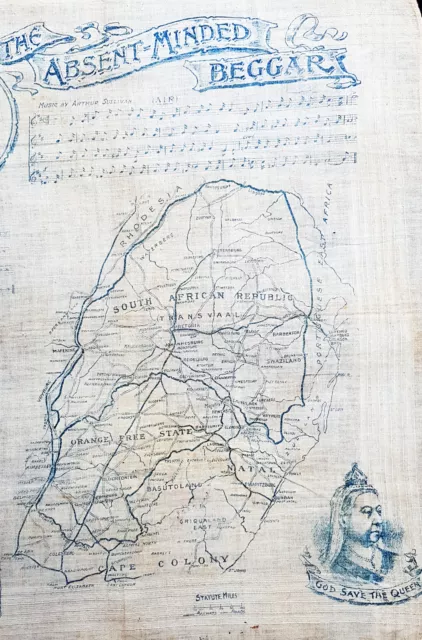- contact us
- ebay profile
- ebay store
The Absent-Minded Beggar.
Cartographer : - Daily Mail Publishing Co. Ltd 1896 -
- Date: - 1899
- Size: - 18in x 17in (465mm x 435mm)
- Ref#: - 93380
- Condition: - (A+) Fine Condition
Description:
This scarce item of ephemera, an original printed linen antique handkerchief, with a map of The South African Republic, was published in 1899 by the Daily Mail to raise funds for the Soldiers Families Fund, after the outbreak of the Second Boer War (1899-1902), the first charitable effort for a war.
The map shows the theatre of war, around the South African Republic (the Transvaal) and the Orange Free State. The two portraits are of Lord Roberts, commander of the British Troops, and Queen Victoria, the British Monarch for the first half of the war.
The poem, The Absent-Minded Beggar by Rudyard Kipling, was specially commissioned for the Fund, and was given a musical score by Arthur Sullivan (of Gilbert & Sullivan fame).
General Definitions:
Paper thickness and quality: - Heavy and stable
Paper color : - off white
Age of map color: - Original
Colors used: - Yellow, green, blue, pink
General color appearance: - Authentic
Paper size: - 18in x 17in (465mm x 435mm)
Plate size: - 18in x 17in (465mm x 435mm)
Margins: - Min 1/2in (12mm)
Imperfections:
Margins: - None
Plate area: - None
Verso: - None
Background:
Despite Roberts portait being entwined in the title, the absent-minded beggar of Kiplings poem is the British Tommy (private soldier), forgetfully leaving their dependents in need while fighting for their country. The Daily Mail paid Kipling £250 for the poem, which he donated to the fund, as did Sullivan with his £100 payment. Soon afterwards Kipling was offered a knighthood, which he declined. It was not Kiplings favourite work: in his autobiography he wrote that it lacked poetry and became wedded... to a tune guaranteed to pull teeth out of barrel-organs. This did not stop it being a huge success, giving the fund the nickname, the Absent-Minded Beggar Relief Corps, and helping it raise £340,000 by the time it was wound up in 1903. Not only was it published worldwide (the New York Journal paid $25 for the privilege), it was recited by actresses including Lily Langtree and Lady Maud Beerbohm Tree.
Organising the fund was a coup for the Daily Mail, which had been founded only in 1896. This campaign capitalised on the jingoistic mood of the British public and the papers circulation soared to over a million issues a day by 1902, the highest in the world.
This handkerchief is probably the most famous item of British ephemera produced during the South African War.
The Absent-Minded Beggar is an 1899 poem by Rudyard Kipling, set to music by Sir Arthur Sullivan and often accompanied by an illustration of a wounded but defiant British soldier, A Gentleman in Kharki, by Richard Caton Woodville. The song was written as part of an appeal by the Daily Mail to raise money for soldiers fighting in the Second Boer War and their families. The fund was the first such charitable effort for a war.
The chorus of the song exhorted its audience to pass the hat for your credits sake, and pay– pay– pay! The patriotic poem and song caused a sensation and were constantly performed throughout the war and beyond. Kipling was offered a knighthood shortly after publication of the poem but declined the honour. Vast numbers of copies of the poem and sheet music were published, and large quantities of related merchandise were sold to aid the charity.
Daily Mail Publishing Co. Ltd 1896 -
The Daily Mail, devised by Alfred Harmsworth (later Viscount Northcliffe) and his brother Harold (later Viscount Rothermere), was first published on 4 May 1896. It was an immediate success. It cost a halfpenny at a time when other London dailies cost one penny, and was more populist in tone and more concise in its coverage than its rivals. The planned issue was 100,000 copies but the print run on the first day was 397,215 and additional printing facilities had to be acquired to sustain a circulation which rose to 500,000 in 1899. Lord Salisbury, 19th-century Prime Minister of the United Kingdom, dismissed the Daily Mail as a newspaper produced by office boys for office boys. By 1902, at the end of the Boer Wars, the circulation was over a million, making it the largest in the world.
With Harold running the business side of the operation and Alfred as Editor, the Mail from the start adopted an imperialist political stance, taking a patriotic line in the Second Boer War, leading to claims that it was not reporting the issues of the day objectively. From the beginning, the Mail also set out to entertain its readers with human interest stories, serials, features and competitions (which were also the main means by which the Harmsworths promoted the paper).
In 1900 the Daily Mail began printing simultaneously in both Manchester and London, the first national newspaper to do so (in 1899, the Daily Mail had organised special trains to bring the London-printed papers north). The same production method was adopted in 1909 by the Daily Sketch, in 1927 by the Daily Express and eventually by virtually all the other national newspapers. Printing of the Scottish Daily Mail was switched from Edinburgh to the Deansgate plant in Manchester in 1968 and, for a while, The People was also printed on the Mail presses in Deansgate. In 1987, printing at Deansgate ended and the northern editions were thereafter printed at other Associated Newspapers plants.
In 1906 the paper offered £10,000 for the first flight from London to Manchester, followed by a £1,000 prize for the first flight across the English Channel. Punch magazine thought the idea preposterous and offered £10,000 for the first flight to Mars, but by 1910 both the Mails prizes had been won. The paper continued to award prizes for aviation sporadically until 1930.
Before the outbreak of World War I, the paper was accused of warmongering when it reported that Germany was planning to crush the British Empire. When war began, Northcliffes call for conscription was seen by some as controversial, although he was vindicated when conscription was introduced in 1916. On 21 May 1915, Northcliffe criticised Lord Kitchener, the Secretary of State for War, regarding weapons and munitions. Kitchener was considered by some to be a national hero. The papers circulation dropped from 1,386,000 to 238,000. Fifteen hundred members of the London Stock Exchange burned unsold copies and called for a boycott of the Harmsworth Press. Prime Minister H. H. Asquith accused the paper of being disloyal to the country.
When Kitchener died, the Mail reported it as a great stroke of luck for the British Empire. The paper was critical of Asquiths conduct of the war, and he resigned on 5 December 1916. His successor David Lloyd George asked Northcliffe to be in his cabinet, hoping it would prevent him from criticising the government. Northcliffe declined.
As Lord Northcliffe aged, his grip on the paper slackened and there were periods when he was not involved. But light-hearted stunts enlivened him, such as the Hat campaign in the winter of 1920. This was a contest with a prize of £100 for a new design of hat – a subject in which Northcliffe took a particular interest. There were 40,000 entries and the winner was a cross between a top hat and a bowler christened the Daily Mail Sandringham Hat. The paper subsequently promoted the wearing of it but without much success. In 1922, when Lord Northcliffe died, Lord Rothermere took full control of the paper.
In 1919, Alcock and Brown made the first flight across the Atlantic, winning a prize of £10,000 from the Daily Mail. In 1930 the Mail made a great story of another aviation stunt, awarding another prize of £10,000 to Amy Johnson for making the first solo flight from England to Australia.
The Daily Mail had begun the Ideal Home Exhibition in 1908. At first, Northcliffe had disdained this as a publicity stunt to sell advertising and he refused to attend. But his wife exerted pressure upon him and he changed his view, becoming more supportive. By 1922 the editorial side of the paper was fully engaged in promoting the benefits of modern appliances and technology to free its female readers from the drudgery of housework. The Mail maintained the event until selling it to Media 10 in 2009.
On 25 October 1924, the Daily Mail published the forged Zinoviev letter, which indicated that British Communists were planning violent revolution. This was thought by some a significant factor in the defeat of Ramsay MacDonalds Labour Party in the 1924 general election, held four days later.
Unlike most newspapers, the Mail quickly took up an interest on the new medium of radio. In 1928, the newspaper established an early example of an offshore radio station aboard a yacht, both as a means of self-promotion and as a way to break the BBCs monopoly. However, the project failed as the equipment was not able to provide a decent signal from overboard, and the transmitter was replaced by a set of speakers. The yacht spent the summer entertaining beach-goers with gramophone records interspersed with publicity for the newspaper and its insurance fund. The Mail was also a frequent sponsor on continental commercial radio stations targeted towards Britain throughout the 1920s and 1930s and periodically voiced support for the legalisation of private radio, something that would not happen until 1973.
From 1923 Lord Rothermere and the Daily Mail formed an alliance with the other great press baron, Lord Beaverbrook. Their opponent was the Conservative Party politician and leader Stanley Baldwin. By 1929 George Ward Price was writing in the Mail that Baldwin should be deposed and Beaverbrook elected as leader. In early 1930 the two Lords launched the United Empire Party which the Daily Mail supported enthusiastically.
The rise of the new party dominated the newspaper and, even though Beaverbrook soon withdrew, Rothermere continued to campaign. Vice Admiral Ernest Augustus Taylor fought the first by-election for the United Empire Party in October, defeating the official Conservative candidate by 941 votes. Baldwins position was now in doubt, but in 1931 Duff Cooper won the key by-election at St Georges, Westminster, beating the United Empire Party candidate, Sir Ernest Petter, supported by Rothermere, and this broke the political power of the press barons.
In 1927, the celebrated picture of the year Morning by Dod Procter was bought by the Daily Mail for the Tate Gallery.
Lord Rothermere was a friend of Benito Mussolini and Adolf Hitler, and directed the Mails editorial stance towards them in the early 1930s. Rothermeres 1933 leader Youth Triumphant praised the new Nazi regimes accomplishments, and was subsequently used as propaganda by them. In it, Rothermere predicted that The minor misdeeds of individual Nazis would be submerged by the immense benefits the new regime is already bestowing upon Germany. Journalist John Simpson, in a book on journalism, suggested that Rothermere was referring to the violence against Jews and Communists rather than the detention of political prisoners.
Rothermere and the Mail were also editorially sympathetic to Oswald Mosley and the British Union of Fascists. Rothermere wrote an article titled Hurrah for the Blackshirts published in the Daily Mail on 15 January 1934, praising Mosley for his sound, commonsense, Conservative doctrine and pointing out that: Young men may join the British Union of Fascists by writing to the Headquarters, Kings Road, Chelsea, London, S.W.
The Spectator condemned Rothermeres article commenting that, ... the Blackshirts, like the Daily Mail, appeal to people unaccustomed to thinking. The average Daily Mail reader is a potential Blackshirt ready made. When Lord Rothermere tells his clientele to go and join the Fascists some of them pretty certainly will.
The papers support ended after violence at a BUF rally in Kensington Olympia in June 1934. Mosley and many others thought Rothermere had responded to pressure from Jewish businessmen who it was believed had threatened to stop advertising in the paper if it continued to back an anti-Semitic party. The paper editorially continued to oppose the arrival of Jewish refugees escaping Germany, describing their arrival as a problem to which the Daily Mail has repeatedly pointed.
On 5 May 1946, the Daily Mail celebrated its Golden Jubilee. Winston Churchill was the chief guest at the banquet and toasted it with a speech. Newsprint rationing in the Second World War had forced the Daily Mail to cut its size to four pages, but the size gradually increased through the 1950s.
The Daily Mail was transformed by its editor during the 1970s and 1980s, David English. He had been editor of the Daily Sketch from 1969 to 1971, when it closed. Part of the same group from 1953, the Sketch was absorbed by its sister title, and English became editor of the Mail, a post in which he remained for more than 20 years. English transformed it from a struggling newspaper selling half as many copies as its mid-market rival, the Daily Express, to a formidable publication, whose circulation rose to surpass that of the Express by the mid-1980s. English was knighted in 1982.
The paper enjoyed a period of journalistic success in the 1980s, employing some of the most inventive writers in old Fleet Street including the gossip columnist Nigel Dempster, Lynda Lee-Potter and sportswriter Ian Wooldridge (who unlike some of his colleagues—the paper generally did not support sporting boycotts of white-minority-ruled South Africa—strongly opposed apartheid). In 1982 a Sunday title, the Mail on Sunday, was launched (the Scottish Sunday Mail, now owned by the Mirror Group, was founded in 1919 by the first Lord Rothermere, but later sold.
What is an Antique Map
The word Antique in the traditional sense refers to an item that is more than a hundred years old. In the past maps were sold in two forms, as a single sheet (broadsheet) or bound in an atlas or book. The majority of antique maps for sale today come from books or atlases and have survived due to the protection offered by the hardback covers.
When considering a purchase
The first thing to determine when staring a collection or purchasing an item, is what is important to you. Most collectors prefer to build their collections around a theme. You may decide to collect maps from one region or country, charting its development through time. Similarly you could collect maps of one particular period in time, by type (i.e. sea or celestial charts) or by cartographer. The collector might also want to consider the theme of cartographical misconceptions such as California as an island or Australia as Terra Australis or the Great Southern Land.
The subject is so wide that any would-be-collector has almost endless possibilities to find his own little niche within the field, and thereby build a rewarding collection.
Starting a collection & pricing
Pricing is based on a number of different factors, the most important of which is regional. In any series of maps the most valuable are usually the World Map and the America/North America. The World because it is usually the most decorative and America because it has the strongest regional market. Other factors that come into play re: price is rarity, age, size, historical importance, decorative value (colour) and overall condition and quality of paper it is printed on.
As specialised dealers, we frequently work with first time map buyers who are just starting their collection. Guiding new collectors on their first antique map purchase and helping new collectors to focus their interests is one of the most rewarding aspects of being an rare map dealer. So please do not hesitate to contact us and we will be happy to help with any questions you may have.
Payment, Shipping & Return Options
Please click on the \"Shipping and Payments\" Tab above for shipping, payment and return details
About US
Classical Images was founded 1998 and has built an excellent reputation for supplying high quality original antiquarian maps, historical atlases, antique books and prints. We carry an extensive inventory of antiquarian collectibles from the 15th to 19th century. Our collection typically includes rare books and decorative antique maps and prints by renowned cartographers, authors and engravers. Specific items not listed may be sourced on request.
Classical Images adheres to the Codes of Ethics outlined by the Antiquarian Booksellers Association of America (ABAA).
We are a primarily an online based enterprise, however our inventory may be viewed by appointment. Please call or email to arrange a viewing.
|
|
| |
| |
|
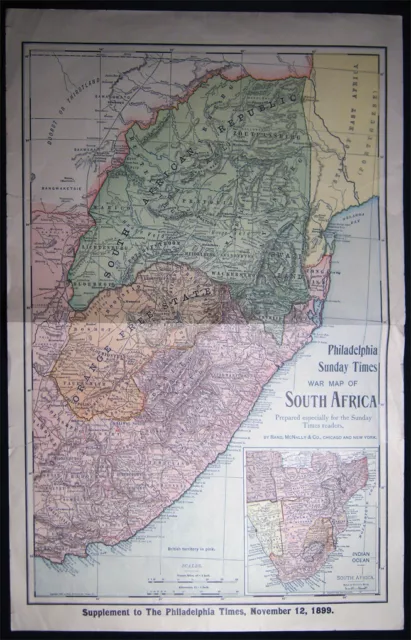
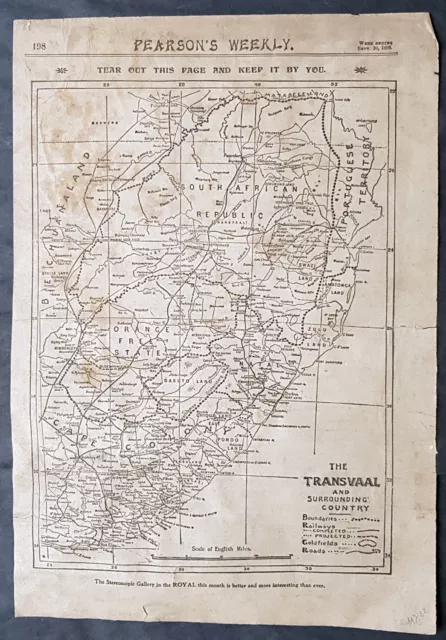
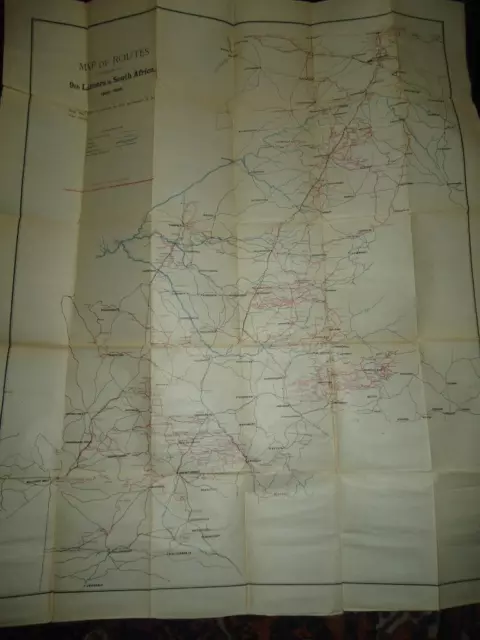


 1 watcher
1 watcher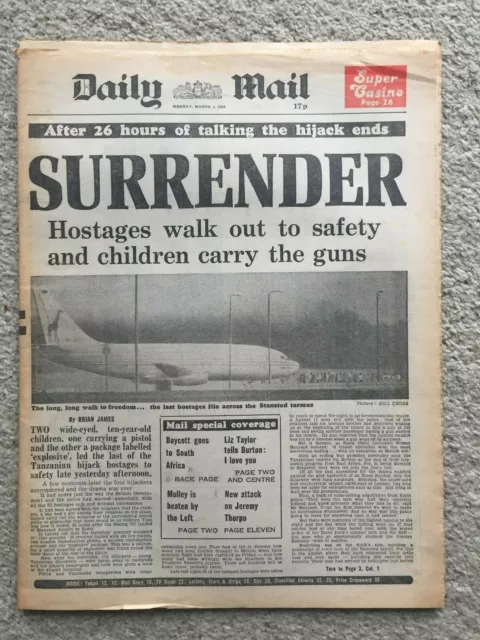
 1 watcher
1 watcher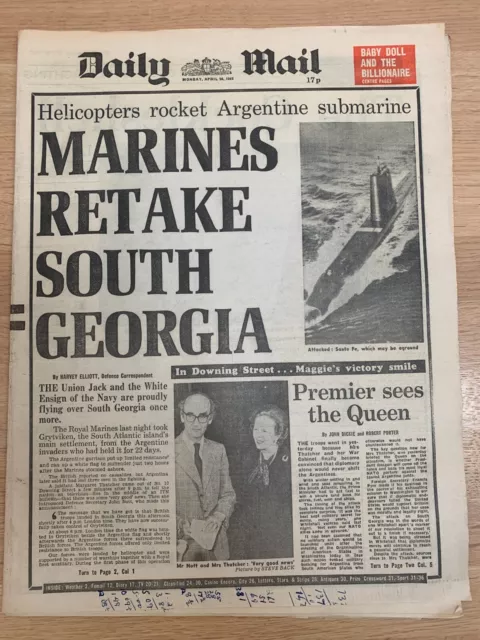 2 watchers
2 watchers
